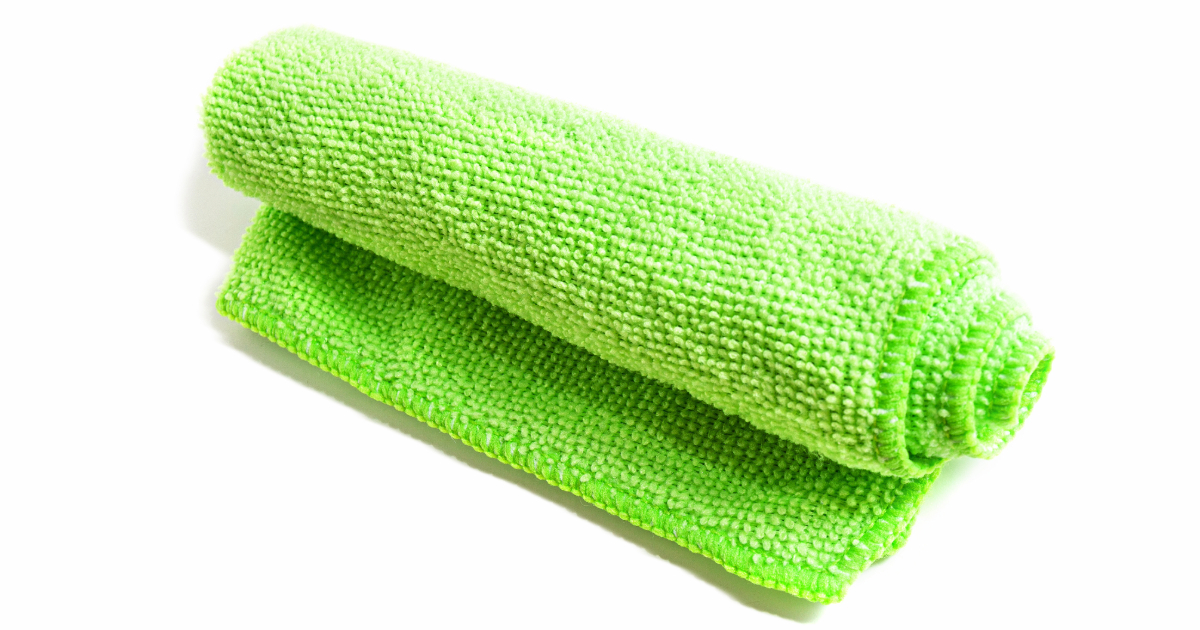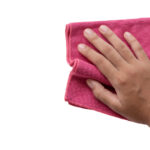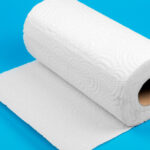Microfiber towels are known for being extremely effective at cleaning and absorbing liquids.

However, some people find that microfiber can leave behind annoying lint and fibers, especially on smooth surfaces like glass or car paint.
So why does microfiber lint, and what can you do about it?
How Microfiber Towels Are Constructed
To understand why microfiber leaves lint, you first need to understand what microfiber is made of.
Microfiber towels are constructed out of extremely fine synthetic fibers that are even finer than human hair. The fibers typically used are polyester or nylon. The fibers are packed very densely together through a process called splitting. This creates a towel that has an incredible amount of surface area for trapping and absorbing liquids and dirt.
The plushness, softness, and cleaning ability of microfiber towels comes from these fine split fibers. However, the same thing that makes microfiber so effective can also cause it to lint.
Why Does Microfiber Lint?
There are a few key reasons why microfiber towels can leave lint behind:
- The tiny fibers can break off – With heavy use and washing over time, some of the fine microfibers can break off or pull loose from the rest of the towel. These loose fibers end up depositing as lint on your surfaces.
- Friction from rubbing releases fibers – The scrubbing, wiping, and buffing motions we use to clean with microfiber creates friction. This can loosen and pull out some of those tiny microfibers.
- The plushness grabs and traps debris – More plush and thick microfiber towels have longer fibers with more space between them. This space easily grabs and traps hairs, fuzz, and other debris from the air and washing machine. Even after washing, some of this debris stays embedded in the microfiber towel.
- Not properly washed – If microfiber isn’t cared for properly, detergent residues, fabric softener, dirt and oils can build up in the towels over time. This residue causes the fibers to degrade faster and lint more.
The linting comes from the towel’s microstructure degrading slowly over time, combined with the towel’s ability to grab and trap lint and debris during use and washing.
Key Takeaway: Microfiber linting is caused by the tiny fibers breaking off, friction wearing them down, and the towel’s plushness trapping debris and lint.
How To Prevent Microfiber Lint
If your microfiber towels are linting, don’t worry! Here are some tips to prevent and reduce microfiber lint:
Buy Quality Towels
Cheaper microfiber is more prone to linting issues over time. Spending a little more upfront for quality microfiber that is tightly constructed will save you hassle down the road.
Quality microfiber is also better about not trapping as much lint and debris internally.
Don’t Buy Overly Plush Towels
Extremely plush, thick towels tend to trap and accumulate more lint in the long fibers. Unless you need that plushness for buffing, try choosing microfiber with a shorter nap or towel pile.
For glass and smooth surfaces, a waffle weave microfiber towel is ideal because debris cannot get trapped between the fibers.
Wash Properly
It’s critical to wash microfiber properly to preserve the integrity of the fibers and prevent buildup of residue:
- Wash microfiber towels separately from cotton towels or laundry
- Use a mild detergent without dyes, fragrances or fabric softener
- Wash on a gentle cycle in warm or cool water
- Never use hot water or bleach
- Dry thoroughly on low heat
Proper washing helps remove debris that causes lint shed. It also prevents detergent buildup that degrades the microfiber over time.
Key Takeaway: Quality microfiber, less plush towels, and proper washing all help reduce linting issues.
Use a Lint Roller
An easy way to remove existing lint, hair and fuzz off your microfiber towels is to use a lint roller. The sticky sheets grab all the debris off the surface of the towel.
You can use a standard lint roller, or try one made specifically for removing pet hair.
Try Masking Tape
Here’s a handy trick for removing lint and debris – ball up a small piece of masking tape and roll/pat it over the surface of your towel. The adhesive will grab onto all the loose fibers and fuzz.
Switch Towel Side or Fold In Half
If you notice lint depositing from your towel to the surface as you clean, simply flip to the clean side of the towel or fold it in half to expose a clean surface.
This helps extend the useful lint-free life of your microfiber towels.
Remove Existing Microfiber Lint
If your microfiber towels left behind lint on your surfaces, here’s how to remove it:
Use Rubbing Alcohol
The best way to remove leftover microfiber lint is using a spray bottle of isopropyl alcohol. Simply spray the alcohol onto the lint, let it soak for 15-30 seconds, and then wipe clean with a lint-free cloth.
The alcohol helps dissolve the fibers so they come up easier. Be sure to test an inconspicuous area first.
Try a Light Touch
For delicate surfaces like glass or paint, lightly brushing the lint with a very soft brush helps lift the lint up without scratching the surface below. A microfiber duster works well.
You can also try a small piece of masking tape pressed very gently to pick up the lint.
Key Takeaway: Rubbing alcohol, dusters, tape or gentle brushes help remove existing lint off surfaces without scratching.
FAQs
Why does my new microfiber towel lint?
Brand new microfiber towels often initially shed some excess lint and fibers left over from manufacturing. This lint will go away after a few washes. Be sure to prep new microfiber towels by washing them 1-2 times before first use.<br>
How do I remove lint from microfiber couch?
Use a lint roller, soft brush, or masking tape as mentioned above to remove lint from microfiber furniture. For stuck-on lint in the fabric, use a fabric shaver tool. Be gentle not to damage the fabric.<br>
Why does microfiber leave white residue?
White residue on surfaces is usually caused by liquid fabric softener and/or dryer sheet buildup on microfiber over many washes. Re-wash your towels using mild soap, no fabric softener, and air dry to remove residues.
Conclusion
While microfiber lint can be annoying at times, there are many simple solutions to deal with it and even prevent it in the first place.
Following the proper care and washing methods keeps your existing microfiber towels lint-free for longer. And removing lint from surfaces is easy using household products like rubbing alcohol or masking tape.








